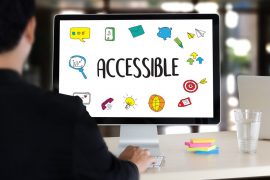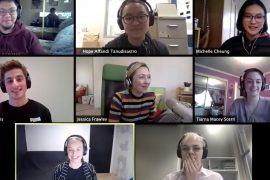Although March 2020 seems to have been going on for about 45 years, we’ve actually only been teaching remotely for just over 2 weeks! Colleagues all over the University have managed to transform their teaching in a very short timeframe and are becoming adept at teaching via Zoom and other technologies.
Thirty days hath September,
April, June, and November,
all the rest have thirty-one
Except March which has 8000— brandAn is good (@LeBearGirdle) March 29, 2020
An addition to Zoom
While Zoom is a great way of providing synchronous (live) classes, there are certainly good arguments for not relying solely on it for content delivery. In addition to potential technical issues, the reliance on live streaming, and the need for students and staff to have a reliable internet connection at the right time, there are many benefits to considering pre-recording unit material instead of synchronous delivery.
Studio, the video recording plugin available in all Canvas sites, is a great asynchronous alternative to live streaming your classes. Asynchronous teaching can be used in addition to synchronous sessions (e.g. delivering ‘lecture’ content via pre-recorded videos and using Zoom for smaller group online discussions) or as an alternative (e.g. content delivery completely as pre-recorded videos and discussion boards for group discussions).
Use Studio or record your Powerpoint slides
You can easily record your lectures in Canvas Studio at your desk. One of the benefits of doing this is that you have more control over your recordings and will end up with a suite of resources for the next time your unit runs.
An alternative to Studio is to record your slides in PowerPoint. This can be done on a Windows PC or on a Mac, and is an easy way to create a video of your slides with a voice over. Once you’ve recorded your slides you should then upload them into Canvas using Studio.
Another advantage is that by pre-recording lecture content you can reduce the stress of live streaming and flip your lecture time for question and answers or other activities. Even better, you can break the lecture into “chunks” which are easy for students to download and digest.
What is ‘chunking?’
Chunking is basically cutting down your lecture content into smaller pieces that are easier for students to digest. Research shows that attention drops rapidly when listening to lectures; most people start losing concentration about 4-5 minutes into a standard delivery lecture. By chunking your content you can insert activities which give students opportunities to get quick feedback (e.g. through a short quiz) or practise a concept (e.g. by posting on a Canvas discussion board or Padlet)
You can flip your content by recording your lectures in Studio and use Zoom for discussions, working through problems, polling, using Padlet for interactivity and collaboration.
Prof Alyson Simpson from the School of Education and Social Work, and Associate Dean (Education) in the Faculty of Arts & Social Sciences, talked about her preference for chunking in the recent Culture Chat: teaching online. She explains the approach to her students, which includes advice on keeping healthy whilst studying:
On this page you will find a number of links to videos that form up the lecture for week 6. Instead of recording one long lecture we have ‘chunked’ the content into a set of short sections each one covers a topic under the global heading of Writing for Real. The first video is a very short intro to how we have set up the lecture. The rest of the videos run from 10 to 15 mins each. Together they make up the full content that we wanted to share with you this week.
Prof Chris Ling from the School of Chemistry is a using variation on this approach:
For my third year materials chemistry lectures, I have been pre-recording the content into two or three 10-15 minute chunks for the students, totalling about 30 minutes per session. In the live Zoom class, students can watch the videos (if they haven’t already) and stop at any time to ask me questions. In the last 10 minutes, we work through a past exam problem together. This is less stressful for me, as I know the students can watch the content before attempting the problems, and I am less reliant on the technology working. Next year, I will have a great set of resources to take my course to the next level.
How can I chunk my lectures?
The easiest way to break content up into smaller chunks is to pick topics or subtopics and record short chunks of content to teach each topic, subtopic, or concept in turn. Think about where you pause in your lecture or change pace – this might be a good place to chunk at, and to insert an activity. Think too about where you ask questions; could you add a quick online quiz instead?
What are the benefits of chunking for students?
Chunking your content can give students greater flexibility in the way they study. They can easily navigate your content by choosing which recordings to listen to. Content can be easily navigated. Instead of an hour (or more) of recorded content that they have to listen to, they can find the sections that they want to listen to. You can provide structure by ordering your content and ensure that students have opportunities to check their understanding. You can also add closed captions to your recordings. On more practical level, providing pre-recorded content means that students are less reliant on internet speed and have a wonderful set of resources from which to revise!
Students, like staff, are now spending lots of time in their homes stuck in front of a screen. By breaking the lecture into chunks, students have the additional flexibility to break up their study time with rest breaks. Alyson Simpson deliberately points this out to students:
I limit my chunks to 10-15 mins and put in a ‘health break’ between each one – I suggest that the students take a break, stretch their legs, drink some water etc.
What are the benefits of chunking for staff?
Potential benefits include a less stressful experience than recording an hour at a time. You can choose to record short sections, which in turn are much easier to edit than a long and unwieldy recording of one or more hours. Once created, your resources can easily be re-used and shared across teaching teams. Your ‘live’ lecture time via Zoom can be used for Q & A sessions, doing worksheets, working on tasks, polling, and getting students to interact more. More radically, you could remove the lecture slot completely and concentrate on small group teaching in tutorials or workshops. Students can be given the structure they need to review the chunked content through mastery quizzes or other required tasks.
Tell me how to do it
We have a step-by-step guide on how to record in Studio available here. There are additional resources on tips and tricks for making recordings here. The following hints are also useful:
Tips for recording
- Use an external microphones
- Find a quiet space to record
- Record a short piece and make sure every works (especially sound)
- Don’t worry too much about errors – being human is good!
Less is more – tips for slide design
- As few words as possible
- Clear diagrams
- Avoid photographs
- Make parts of the slide appear bit by bit – it works as a prompt for you and reduces reading load for students
Other features and advanced techniques
- Auto-add captions and then then spend a bit of time correcting these
- Allow “Comments” in Canvas Studio videos
- Add questions: either using questions within Studio, a Canvas quiz straight after, or a discussion board prompt






4 Comments